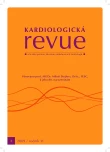Rehabilitation of patients with ischemic heart disease
Authors:
V. Chaloupka
Authors‘ workplace:
IKK FN Brno-Bohunice
Published in:
Kardiol Rev Int Med 2009, 11(2): 58-62
Overview
Rehabilitation of patients with ischemic heart disease. Rehabilitation represents an inseparable part of a comprehensive treatment of patients with ischemic heart disease. Enabling the patients to return to work and leisure activities to the maximum extent possible is one of the main aims of rehabilitation. While aerobic training activities form the basis of physical exercise, resistance exercises are also commonly included. Originally, the focus was on post‑MI and revascularization patients. Rehabilitation of these patients has become an integral part of comprehensive care in many countries. Recent meta‑analysis has shown significant 27% reduction of overall and 31% reduction of cardiovascular mortality. However, the attention gradually refocuses on other patients too: older patients with a range of other pathologies, i.e. a highly important issue with respect to the aging population, patients after heart defect surgery as well as patients at high risk, including patients with heart failure. It is these patients who might benefit most from the improvement of stress tolerance and aerobic capacity. The mechanisms by which physical activity and fitness decrease mortality have not yet been fully elucidated; they are linked to risk factors reduction. However, the effect of physical exercise is an independent factor in mortality reduction.
Keywords:
rehabilitation – ischemic heart disease – heart failure – myocardial infarction – cardiovascular mortality
Sources
1. Hellerstein HK, Ford AB. Rehabilitation of the cardiac patient. J Amer Med Assoc 1957; 164 : 225–231.
2. WHO Committee. Rehabilitation after cardiovascular disease, with special emphasis on developing countries: a report of a WHO Committee. World Health Organ Tech Rep Ser 1993; 831 : 1–122.
3. Joliffe JA, Rees K, Taylor RS et al. Exercise‑based rehabilitation for coronary heart disease. Oxford: Update Software 2002.
4. Chaloupka V, Siegelová J, Špinarová L et al. Rehabilitace u nemocných s kardiovaskulárním onemocněním. Doporučené postupy ČKS. Cor Vasa 2006; 48: K127–K145.
5. Blair SN, Kampert JB, Kohl HW 3rd et al. Influences of cardiorespiratory fitness and other precursors on cardiovascular disease and all‑cause mortality in men and women. JAMA 1996; 276 : 205–210.
6. Pescatello LS, Fargo AE, Leach CN Jr et al. Short‑term effect of dynamic exercise on arterial blood pressure. Circulation 1991; 83 : 1557–1561.
7. Blair SN. Evidence for success of exercise in weight loss and control. Ann Intern Med 1993; 119 : 702–706.
8. Tran ZV, Weltman A. Differential effect of exercise on serum lipid and lipoprotein levels seen with changes in body weight. JAMA 1985; 254 : 919–924.
9. Williams PT. High‑density lipoprotein cholesterol and other risk factors for coronary heart disease in female runners. N Engl J Med 1996; 334 : 1298–1303.
10. Stratton JR, Chandler WL, Schwartz RS et al. Effects of physical conditioning on fibrinolytic variables in young and old healthy adults. Circulation 1991; 83 : 1692–1697.
11. Rauramaa R, Salonen JT, Seppänen K et al. Inhibition of platelet aggregability by moderate-intensity physical exercise: a randomized clinical trial in overweight men. Circulation 1986; 74 : 939–944.
12. Charo S, Gokce N, Vita JA. Endothelial dysfunction and coronary risk reduction. J Cardiopulm Rehabil 1998; 18 : 60–67.
13. Jančík J, Várnayová L, Siegelová J et al. Heart rate variability in patients with chronic ischemic heart disease: effect of 8‑week exercise training. In: Halberg F, Kenner T, Fišer B (eds). Proceedings of symposium The importance of chronobiology in diagnosing and therapy of internal diseases. IDVPZ Brno 2002 : 179–184.
14. Belardinelli R, Georgiou D, Ginzton L et al. Effects of moderate exercise training on thallium uptake and contractile response to low‑dose dobutamine of dysfunctional myocardium in patients with ischemic cardiomyopathy. Circulation 1998; 97 : 553–561.
15. Gould KL, Ornish D, Kirkeeide R et al. Improved stenosis geometry by quantitative coronary angiography after vigorous risk factor modification. Am J Cardiol 1992; 69 : 845–853.
16. Niebauer J, Hambrecht R, Velich T et al. Attenuated progression of coronary artery disease after 6 years of multifactorial risk intervention: role of physical exercise. Circulation 1997; 96 : 2534–2541.
17. Gwirtz PA, Brand MA, Mass HJ et al. Endurance training alters arterial baroreflex function in dogs. Med Sci Sports Exerc 1990; 22 : 200–206.
18. Jančík J, Svačinová H, Siegelová J et al. Baroreflex sensitivity in patients with chronic coronary artery disease: influence of eight weeks exercise training. Scripta medica 2001; 74 : 39–44.
19. Green HJ, Jones LL, Hughson RL et al. Training‑induced hypervolemia: lack of an effect on oxygen utilization during exercise. Med Sci Sports Exerc 1987; 19 : 202–206.
20. Mayer K, Samek L, Schwailbold S et al. Physical response to different modes of interval exercise training in patients with chronic heart failure – application to exercise training. Eur Heart J 1996; 17 : 1040–1047.
21. Williams MA, Haskell WL, Ades PA et al. Resistance Exercise in Individuals With and Without Cardiovascular Disease: 2007 Update: a scientific statement from the American Heart Association Council on Clinical Cardiology and Council on Nutrition, Physical Activity, and Metabolism. Circulation 2007; 116 : 572–584.
22. Chaloupka V, Elbl L, Nehyba S. Silový trénink u nemocných po infarktu myokardu. Vnitř Lék 2000; 46 : 829–834.
23. ACSM‘s Guidelines for exercise testing and Prescription. 6th ed. Lippincott Williams&Wilkins 2000.
24. Camm AJ, Lüscher TF, Serruys PW. The ESC Text Book of Cardiovascular Medicine. Oxford: Blackwell Publishing 2006.
25. Colleta AP, Clark AL, Cleland JG. Clinical trials update from the Heart Failure Society of America and the American Heart Association meetings in 2008: SADHART-CHF, COMPARE, MOMENTUM, thyroid hormone analogue study, HF-ACTION, I-PRESERVE, {beta}-interferon study, BACH, and ATHENA. Eur J Heart Fail 2009; 11 : 214–219.
Labels
Paediatric cardiology Internal medicine Cardiac surgery CardiologyArticle was published in
Cardiology Review

2009 Issue 2
Most read in this issue
- Diagnosis and treatment mistakes in acute forms of ischaemic heart disease
- Immunosuppression treatment following heart transplantation
- Cardiometabolic risk is a threat for the 21st century cardiology
- Rehabilitation of patients with ischemic heart disease
